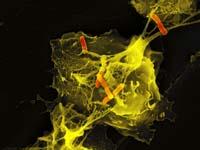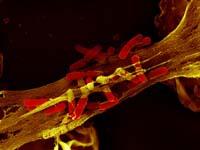DNA networks for protection
2006/04/30 Galarraga Aiestaran, Ana - Elhuyar Zientzia

The immune system is responsible for dealing with the continuous attacks of the body, both by external and internal agents. For this purpose it uses different mechanisms and strategies. Among them are specialized cells for the capture and destruction of aggressors, among which are neutrophils.
The neutrophils fight against the bacteria that enter the body in two ways: on the one hand, they release toxic substances that surround them, but above all they phagocyte the bacteria. That is, they surround, internalize and digest pathogenic bacteria. Eat, swallow, eat the enemy.
DNA network

But it's not all that. In 2004, researchers at the Max Planck Institute found that neutrophils use another mechanism. Until then no one had noticed it and the researchers surprised him at the beginning. In fact, they demonstrated that neutrophils launch networks to catch the aggressors. And these networks are made of DNA and proteins. Specifically, the neutrophils use the DNA of their nucleus to work these networks.
The researchers already realized that the DNA threads were present in the samples used by the laboratory, but they believed it was extracted when breaking the cells. They did not even suspect that the cell itself releases its DNA. Delving deeper into research, they found that DNA networks are really effective in destroying microorganisms.
The DNA molecule does not present an intrinsic activity against microorganisms, but its physical characteristics give it the protection capacity by not forming a two-metre viscous mesh. In addition, some proteins are intercalated in the network. They are histones.
Histones, which accompany DNA in the nucleus of cells, allow DNA to acquire the form of chromosome. But not only that, unlike DNA, histones have microbicidal power.
The DNA network also serves to prevent the dispersion of toxic substances released by neutrophils. Although it releases these substances against microorganisms, they also damage the cells of the body, so it should not extend them in excess.
Continue investigating

The DNA network captures bacteria. (Photo: Max Planck Institute)
Last year, researchers at the University of Minnesota found that in fertilization the neutrophils use their DNA to capture sperm microorganisms. It also captures sperm, but these have an enzyme that destroys DNA and are therefore released from the network. Some cases of sterility are due to excess DNA.
Researchers continue to have many outstanding questions. Among other things, they want to know how it comes out of the nucleus and if it is related to autoimmune diseases. And, going a step further, they begin to analyze whether it can be used to cure some diseases.
Published in 7K.




